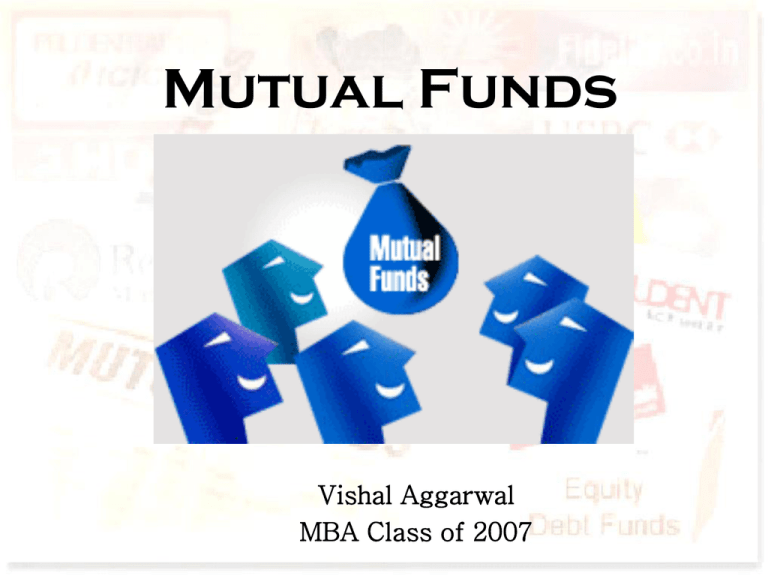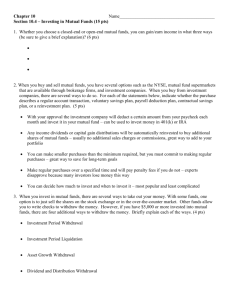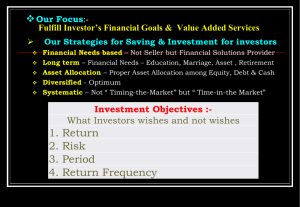Mutual Funds - Itworkss.com
advertisement

Mutual Funds Vishal Aggarwal MBA Class of 2007 Disclaimer • Me - no expert • Not Comprehensive • Majority from websites and some practical experience Contents Mutual Fund Defined Brief History Regulations Organization of Mutual Fund Terminologies Demystified Types of Schemes Risk Behavior Investment Strategies Equity Funds Buying a Mutual Fund Selecting a Mutual Funds Mutual Funds Comparision Keeping Track Warning Signals Reference Websites Mutual Fund ?? • Form of trust that pools the funds of a whole lot of investors to make more money by investing in an array of financial instruments. • Advantages of a MF – – – – – Professional Management Diversification Flexibility in choice - selection, redemption Low costs Transparency Brief History • 1964-UTI • 1987- Public Sector banks, Insurance Companies – SBI, Canbank, PNB LIC, GIC • 1993- Private Sector – Kothari Pioneer ( later merged with Franklin Templeton), J P Morgan, Morgan Stanley, George Soros and Capital International Organization of a Mutual Fund Adobe Acrobat 7.0 Document Regulations • Governed by SEBI (Mutual Fund) Regulation 1996 – All MFs registered with it, constituted as trusts ( under Indian Trusts Act, 1882) • Bank operated MFs supervised by RBI too • AMC registered as Companies registered under Companies Act, 1956 • SEBI- Very detailed guidelines for disclosures in offer document, offer period, investment guidelines etc. – NAV to be declared everyday for open-ended, every week for closed ended – Disclose on website, AMFI, newspapers – Half-yearly results, annual reports – Select Benchmark depending on scheme and compare Terminologies Demystified… • Asset Allocation – Diversifying investments in different assets such as stocks, bonds, real estate, cash in order to optimize risk. • Fund Manager – The individual responsible for making portfolio decision for a mutual fund, in line with fund’s objective. • Fund Offer Document – Document with investment objectives, risk factors, expenses summary, how to invest etc. • • Dividend – Profits given to the investor from time to time. Adobe Acrobat 7.0 Document Growth – Profits ploughed back into scheme. This causes the NAV to rise. Terminologies Contd… • NAV – Market value of assets of scheme minus its liabilities. • Per unit NAV • Entry Load/Front-End Load (0-2.25%) – – • – Price you pay to invest in a scheme. May include a sales load. (In this case, sale price is higher than NAV) Re-Purchase Price/ Bid Price – • The commission or charge paid when an investor exits from a mutual fund. Imposed to discourage withdrawals May reduce to zero as holding period increases. Sale Price/ Offer Price – • The commission charged at the time of buying the fund. To cover costs for selling, processing Exit Load/Back- End Load (0.25-2.25%) – • = Net Asset Value No. of Units Outstanding on Valuation date Price at which close-ended scheme repurchases its units Redemption Price – Price at which open-ended scheme Types of Mutual Fund Schemes • By Structure – Open-Ended – anytime enter/exit – Close-Ended Schemes – listed on exchange, redemption after period of scheme is over. • By Investment Objective – Equity (Growth) – only in Stocks – Long Term (3 years or more) – Debt (Income) – only in Fixed Income Securities (3-10 months) – Liquid/Money Market (including gilt) – Short-term Money Market (Govt.) – Balanced/Hybrid – Stocks + Fixed Income Securities (1-3 years) • Other Schemes – Tax Saving Schemes – Special Schemes • ULIP Adobe Acrobat 7.0 Document Risks • Historical analysis – Return is remembered, Risk forgotten • Risk = Potential for Harm • Market Risk • Non-Market Risk • Credit Rate Risk • MF Risk = Volatility (fluctuation of NAV) – Standard Deviation – Websites give star rating ( basis = risk-adjusted return) Investment strategies • Systematic Investment Plan (SIP) – Invest a fixed sum every month. (6 months to 10 yearsthrough post-dated cheques or Direct Debit facilities) – Fewer units when the share prices are high, and more units when the share prices are low. Average cost price tends to fall below the average NAV. • Systematic Transfer Plan (STP) – Invest in debt oriented fund and give instructions to transfer a fixed sum, at a fixed interval, to an equity scheme of the same mutual fund. • Systematic Withdrawal Plan (SWP) Before declaration of dividend / bonus Growth Dividend payout Dividend reinvestment Bonus NAV 20 20 20 20 Units 100 100 100 100 Value (Rs) 2,000 Rs 2,000 Rs 2,000 Rs 2,000 After declaration of dividend / bonus NAV 20 19 19 18.1818 Units 100 100 105.2631 110 Value (Rs) 2000 1900 2000 2000 Dividend received in cash - Rs 100 - - Additional units - - 5.2631 10 Equity Funds • • • • • • • • Diversified equity funds Index funds Opportunity funds Mid-cap funds Equity-linked savings schemes Sector funds like Auto, Health Care, FMCG etc Dividend Yield Funds Others (Exchange traded, Theme, Contra etc) Investing in Equity Funds • Errors – Invest in only top performing funds – These cannot go wrong – Replicate past performance in future • Appropriate way – Right Mix of equity MFs (Top 3-4 funds, may all be mid-cap funds) – Have variety of funds like diversified funds, mid-cap funds and sector funds – in right proportion. – Beginner- it makes sense to begin with a diversified fund – Gradual exposure to sector and specialty funds. • Look at performance of various funds with similar objectives for at least 3-5 years (managed well and provides consistent returns) Tired of your savings account? • Extra Cash in savings A/c?? Consider Cash Funds • Liquidity: Savings account wins – b/w a savings account and a fixed deposit, no ATM (NowRel Regular Savings Fund) • Safety: Savings account wins – All mutual funds are subject to market risks • Returns: Cash funds win – Upto about 17.5% return • Performance: Cash funds win – Interest rate fluctuations covered by quick maturation • Invest when surplus money in savings a/c based on expense ratio Investing Checklist • Draw up your asset allocation – Financial goals & Time frame (Are you investing for retirement? A child’s education? Or for current income? ) – Risk Taking Capacity • Identify funds that fall into your Buy List • Obtain and read the offer documents • Match your objectives – In terms of equity share and bond weightings, downside risk protection, tax benefits offered, dividend payout policy, sector focus • Check out past performance – Performance of various funds with similar objectives for at least 3-5 years (managed well and provides consistent returns) Checklist Contd… • Think hard about investing in sector funds – For relatively aggressive investors – Close touch with developments in sector, review portfolio regularly • Look for `load' costs – Management fees, annual expenses of the fund and sales loads • Does the fund change fund managers often? • Look for size and credentials – Asset size less than Rs. 25 Crores • Diversify, but not too much • Invest regularly, choose the S-I-P – MF- an integral part of your savings and wealth-building plan. Portfolio Decision • The right asset allocation – Age = % in debt instruments – Reality= different financial position, different allocation – Younger= Riskier • Selecting the right fund/s – Based on scheme’s investment philosophy – Long-term, appetite for risk, beat inflation– equity funds best • TRAPS TO AVOID – IPO Blur • Begin with existing schemes (proven track record) and then new schemes – Avoid Market Timing MF Comparison • Absolute returns – % difference of NAV – Diversified Equity with Sector Funds– NO • Benchmark returns – SEBI directs – Fund's returns compared to its benchmark • Time period – Equal to time for which you plan to invest – Equity- compare for 5 years, Debt- for 6 months • Market conditions – Proved its mettle in bear market Buying Mutual Funds • Contacting the Asset Management Company directly – Web Site – Request for agent • Agents/Brokers – Locate one on AMFI site • Financial planners – Bajaj Capital etc. • • Insurance agents Banks – Net-Banking – Phone-Banking – ATMs • Online Trading Account – ICICI Direct – Motilal Oswal, Indiabulls- Send agents Keeping Track… • Filling up an application form and writing out a cheque= end of the story… NO! • Periodically evaluate performance of your funds – – – – Fact sheets and Newsletters Websites Newspapers Professional advisor Adobe Acrobat 7.0 Document Adobe Acrobat 7.0 Document Warning Signals • • • • • Fund's management changes Performance slips compared to similar funds. Fund's expense ratios climb Beta, a technical measure of risk, also climbs. Independent rating services reduce their ratings of the fund. • It merges into another fund. • Change in management style or a change in the objective of the fund. Websites • http://news.moneycontrol.com/mf/glossary.php • http://www.investopedia.com/university/mutualfunds/default.asp • http://www.valueresearchonline.com • http://www.amfiindia.com/ • http://www.sbimf.com/portal/static/calculator/RiskAssess/RiskAssessCal1.asp • http://www.mutualfundsindia.com/resourcecentre.asp





